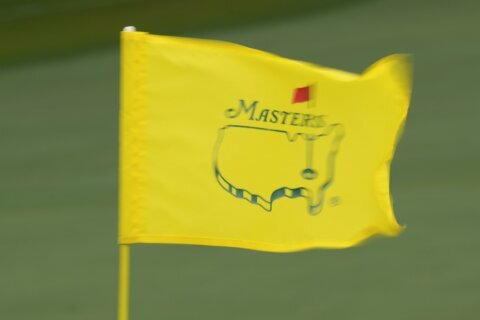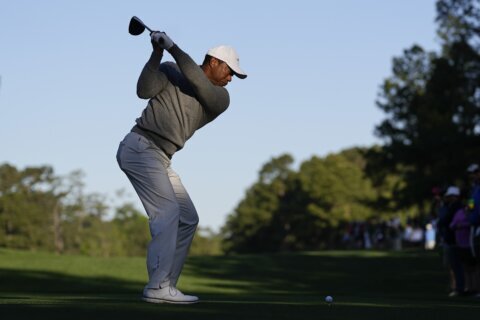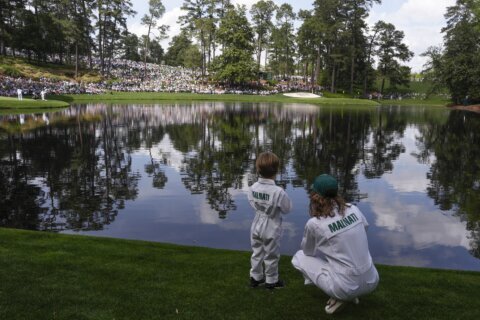SHEBOYGAN, Wis. (AP) — Ian Poulter is never short on emotion in the Ryder Cup, usually with his eyes as big as golf balls. This was different.
He crouched with his head bowed for the longest time on the side of the 16th green at Whistling Straits after winning a match in a losing cause for Europe.
Part of his emotions were realizing this might be his last time competing, his last time slamming his fist against the European crest on his shirt. When age (45) and world ranking (50) are not far apart, there are no guarantees.
And part of him thought about European captain Padraig Harrington, and the inevitable criticism and second-guessing that follows a captain who leaves without the gold trophy.
“This is going to be hard, because Paddy is going to be questioned,” Poulter told Sky Sports. “And that’s not fair.”
There was little Harrington could have done over three days at Whistling Straits against an American team that had the best credentials, hit all the right shots and made all the big putts.
Tommy Fleetwood played only twice in team sessions, a halve and a loss, both in fourballs. He was 4-0 with Francesco Molinari in the famous “Moliwood” pairing in 2018 outside Paris. Fleetwood was No. 12 in the world back then. He is No. 37 now, having gone 41 starts since his last victory. Form matters more than history.
This was not a bad European team, just a team that wasn’t performing well away from home. Jim Furyk can appreciate that from his captaincy in France.
The question going forward is what Europe will look like when the Ryder Cup goes to Italy.
Two years is a long way off, plenty of time for future stars to emerge, whether that’s Matthias Schmid of Germany, Robert MacIntyre of Scotland or the 20-year-old Danish twins, Rasmus and Nicolai Hojgaard, who won in consecutive weeks on the European Tour.
Remember, Collin Morikawa was still in college when Europe trounced the Americans in the last Ryder Cup. He went 3-0-1 in his debut. Scottie Scheffler had just graduated from Texas in 2018. He delivered perhaps the biggest putt for the Americans in his fourballs match, and he steamrolled world No. 1 Jon Rahm in singles.
The greater concern is what the European Tour will look like in 2023.
Among the questions facing Harrington was his decision to reduce his captain’s picks from four to three, especially over the uncertainty from a pandemic that led to a one-year postponement.
He wanted the leading four players to come from points earned at European Tour events, and the next five from world ranking points that were earned (not just position in the ranking).
Steve Stricker opted for six picks instead of four. He wound up taking the top eight from the U.S. standings, anyway, the normal number of qualifiers.
Harrington said even if he had four picks, he wouldn’t have skipped the last qualifier — Bernd Wiesberger, in this case.
Of those left off, who really would have made a difference based on form? They had experience, sure, but Europe already had loads of that.
“The Ryder Cup in Europe represents the European Tour as much as Europe itself,” Harrington said when he announced his three picks. “It’s very important that the players in Europe have that opportunity to play their way into the team.
“Anybody playing in Europe has a chance to make the team, and that’s the way it should be,” he said. “We don’t want to do the ranking off the PGA Tour rankings. We want to do it off our European system.”
That’s how Jamie Donaldson made the team in 2014 before he delivered the clinching point at Gleneagles. It’s how Paul Lawrie made the 2012 team. His 5-and-3 win over Brandt Snedeker was the shortest singles match at Medinah. All of them mattered that day in Europe’s stunning comeback victory.
A strong European Tour is important for golf and for the Ryder Cup.
The coronavirus pandemic has been particularly harsh on the European Tour, which has done well to at least put on a full schedule. Still, the disparity is greater than ever.
The PGA Tour had nine tournaments this season that paid roughly $1.5 million to the winner. Europe had 12 tournaments in which that was about the size of the entire purse. That didn’t include the four majors and three World Golf Championships, all but one played in America.
At this rate, emerging players on the European Tour are not getting the level of competition they need to develop.
Wiesberger was the only Ryder Cup player for Europe who wasn’t a PGA Tour member. What will it look like two years from now? Four years?
The PGA Tour and European Tour are starting to work together, such as the Scottish Open being part of the U.S. schedule and European Tour members having access to lower-tier PGA Tour events. How that develops remains to be seen.
The Presidents Cup, which gives countries outside Europe a chance at team competition, once was described as a match between the U.S. and Florida because so many International team members lived there and played practically all their golf on the PGA Tour.
That’s a perception Europe would do well to avoid.
___
More AP golf: https://apnews.com/hub/golf and https://twitter.com/AP_Sports
Copyright © 2024 The Associated Press. All rights reserved. This material may not be published, broadcast, written or redistributed.







